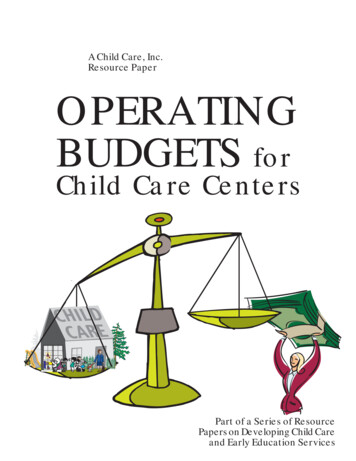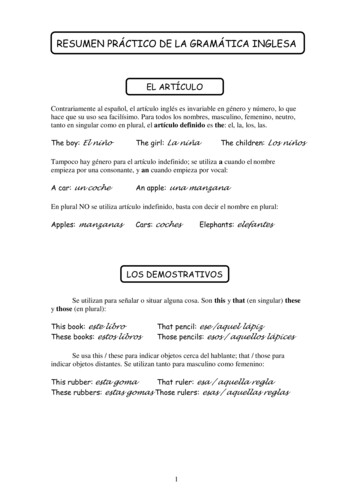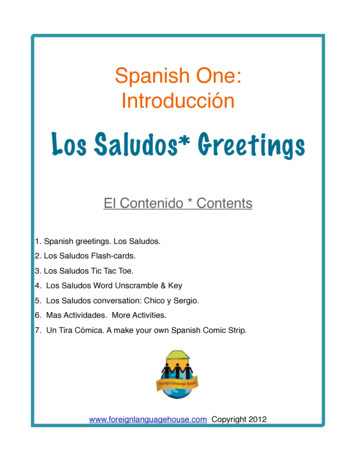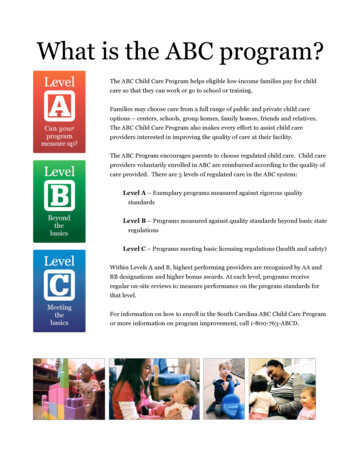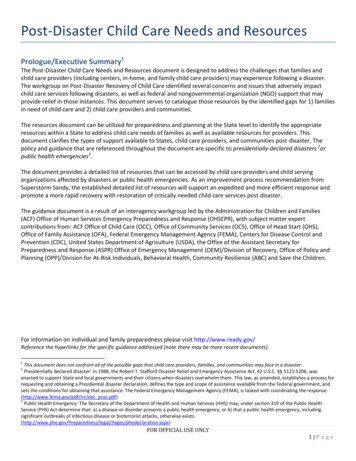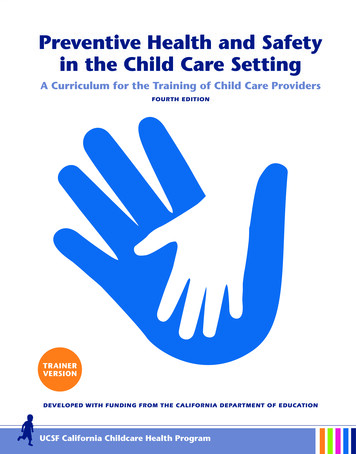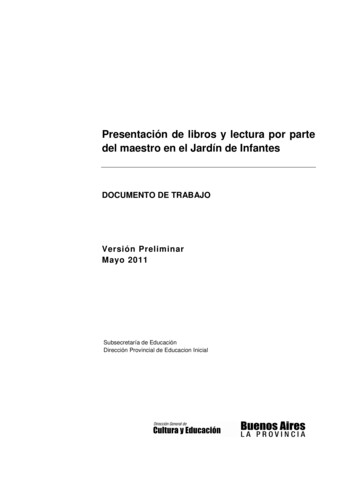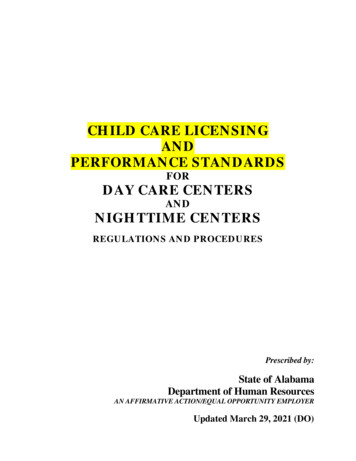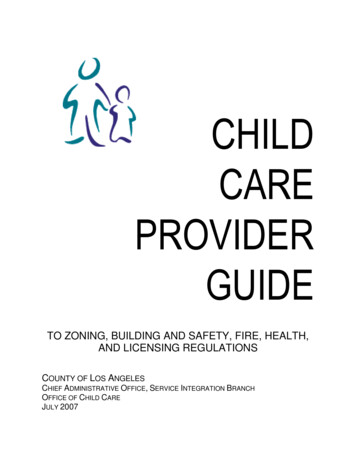
Transcription
CHILDCAREPROVIDERGUIDETO ZONING, BUILDING AND SAFETY, FIRE, HEALTH,AND LICENSING REGULATIONSCOUNTY OF LOS ANGELESCHIEF ADMINISTRATIVE OFFICE, SERVICE INTEGRATION BRANCHOFFICE OF CHILD CAREJULY 2007
COUNTY OF LOS ANGELESCHILD CARE PROVIDER GUIDEBOARD OF SUPERVISORSGLORIA MOLINAFirst DistrictYVONNE B. BURKESecond DistrictZEV YAROSLAVSKYThird DistrictDON KNABEFourth DistrictMICHAEL D. ANTONOVICHFifth DistrictWILLIAM T FUJIOKAChief Executive OfficerKATHY HOUSEManager, Chief Executive OfficeKATHLEEN MALASKE-SAMUDirector, Office of Child Care222 South Hill Street, 5th FloorLos Angeles, California 90012Office: (213) 974-4103Fax: (213) 217-5106www.childcare.lacounty.govRevised: July 2007
TABLE OF CONTENTSIntroduction 1Small Family Child Care HomesFlow Chart .5Overview of Estimated Fees .6Zoning .7Building and Safety .7Fire Safety Clearance .8Business License .8State License for Child Care .8Insurance . 12Americans with Disabilities Act . 13Connecting with Child Care Resource and Referral Agencies . 13Large Family Child Care HomesFlow Chart .Overview of Estimated Fees .Zoning .Building and Safety .Fire Safety Clearance .Business License .State License for Child Care .Insurance .Americans with Disabilities Act .Connecting with Child Care Resource and Referral Agencies .17181921212424272828Child Care CentersFlow Chart .Overview of Estimated Fees .Zoning .Building and Safety .Public Health License .Fire Safety Clearance .Business License .State License for Child Care .Connecting with Child Care Resource and Referral Agencies .313234374042454550
Resource DirectoryCounty of Los Angeles Departments .State Child Care Licensing .Criminal Record Clearance (Fingerprinting) Tuberculosis (TB) Skin Testing . Child Care Resource and Referral Agencies .Legal Services .Children with Special Needs .Technical Assistance: Planning and Financing Professional Organizations .535555565758585959AppendicesAppendix A Notice of Intent to Establish a Large Family Child CareHome in the Unincorporated Areas of Los Angeles CountyAppendix B Sample Plot Plan for Large Family Child Care HomeAppendix C Site Plan for ReviewAppendix D Sample Plot Plan for Child Development CenterAppendix E Notice to Prospective Businesses – Statement of IntendedUseii
INTRODUCTIONWe are delighted to learn of your interest in offering child care and developmentservices! The demand for high quality, licensed child care and development programscuts across Los Angeles County. This Child Care Provider Guide (Guide) is one part ofthe County’s effort to promote and facilitate the development of quality, licensed childcare options that are also affordable and accessible to families. We hope to work withyou in developing these needed services.As you browse through the Guide, you will find that providing quality, licensed child careis as challenging and demanding as it is rewarding. During the first five years of achild’s life, incredible physical, emotional, social, and cognitive growth takes place.Developmentally appropriate child care services can support and enhance this growth.Inappropriate care during these early years can undermine or damage a child’s ability torealize his or her full potential. Even though child care involves a lot of hugs, tickles,and giggles, it is a very serious enterprise.Many prospective child care providers are amazed at the number and complexity ofgovernment agencies that regulate child care programs. This Guide is intended toassist you by clarifying which regulations govern which types of child care services.Three models of care are reviewed in this Guide: Small Family Child Care HomesLarge Family Child Care HomesChild Care CentersThe Guide will be most helpful for persons developing programs in the unincorporatedareas of Los Angeles County. However, centers throughout the County with theexception of those operating in Long Beach, Pasadena, and Vernon1 must obtain aPublic Health License from the Department of Public Health. Otherwise, if you areinterested in providing child care within an incorporated city in Los Angeles County, youwill need to research the zoning and fire regulations of that particular city.Every effort has been made to provide you with the most current information on thedevelopment of a child care program within the unincorporated areas of Los AngelesCounty. Please be aware, however, that regulations and their interpretations changewith alarming speed and most often do so immediately after you have committed oneversion to print! We urge you to use this document as a guide and to researchthoroughly all aspects of developing a child care service before making any financial orconstruction decisions. Lastly, a Resource Directory is provided at the end of the Guideto help you locate the appropriate government entities and organizations referencedthroughout the document.1Centers operating in Long Beach, Pasadena, and Vernon should contact their respective local HealthDepartment to learn about the requirements for food service and other health concerns in that city.1
Once you have digested this material, you will want to follow these first steps:STEP 1.Decide on the type of licensed child care – family child care home, or center – youwould like to offer and think about the ages and number of children you wish to serve.You may also want to think about the families you plan to serve and how they will payfor your services.STEP 2.Attend a Child Care Licensing Orientation meeting. Orientations are mandatory if youplan to open a licensed family child care home or center. There is a non-refundable feeof 25 for prospective family child care providers and 50 for prospective centers thatmust be paid by personal check, cashiers check, or money order payable to:California Department of Social Services (DSS). Your licensing application is due withinone year of attendance. Call your local Regional Office listed in the CommunityResources section of this Guide for information on the orientation schedule and toregister. You may also visit the DSS, Community Care Licensing Division (CCLD)web site at www.ccld.ca.gov to view the orientation schedule and for more informationand updates on licensing.STEP 3.Identify a site for your family child care home or center and prepare basic site and floorplans.STEP 4.Whether you are planning to use an existing site, plan to remodel, or begin newconstruction, consult with a planner at the Land Development Coordinating Centerlocated at the Department of Regional Planning (see Resource Directory section). Theplanner is available to meet with you, discuss your project, and offer both time- andcost-saving suggestions. Prospective family child care providers may walk-in for aconsultation from 7:30 a.m. to 6:00 p.m. Monday through Thursday; be sure to bring tothe consultation the following information and materials: assessor parcel number oraddress; your proposed plan, including the number of children you plan to serve; and asite plan showing your property. Prospective centers are encouraged to schedule anappointment with a planner by calling (213) 974-6411. Centers should bring to theirconsultation the following information and materials: plot plan, including how you planto address parking for your staff and families; the number of children you plan to serve;and your projected number of employees. Additional resources for technical assistancemay be found in the Resource Directory contained in this Guide.2
SMALLFAMILYCHILDCAREHOMES3
This section was intentionally left without content.4
SMALL FAMILY CHILD CARE HOMESProvider applicant attendslicensing orientation meeting.ÐProvider applicant submitscompleted application tolicensing office.ÐLicensing Program Analystreviews application and, ifcomplete, conducts site visit;recommends licensure;supervisor agrees.ÐLicense is issued.ÐChild care may be provided.This chart represents a simplified overview of the process.5
OVERVIEW OF ESTIMATED FEES:SMALL FAMILY CHILD CARE HOMESGovernment entities often impose fees to recover their costs for conducting business,including the regulation of child care programs. The chart below illustrates thegovernment entities that you will encounter and their fees. Note that fees are subject tochange, in some cases annually.STATE LICENSE FOR CHILD CAREOrientation Fee 25.00Application/Annual Licensing Fee 60.00CLEARANCESCriminal Record Clearance2 55.00 per personTuberculosis Test and ResultsDepends32The Criminal Record Clearance includes the Department of Justice (DOJ) fee (none), the FBI fee ( 24),the DOJ Child Abuse Central Index (CACI) fee ( 15), and the LiveScan Fee ( 16). The LiveScanprocessing fee may vary depending on the agency that does it; this is Community Care Licensing’sLiveScan processing fee.3Fees for TB skin tests and results for individuals may vary from free to 25 depending on where and bywhom the testing is conducted.6
SMALL FAMILY CHILD CARE HOMESSmall family child care is defined by the California Health and Safety Code as regularlyprovided care, protection, and supervision of children in the caregiver’s own home forperiods of less than 24 hours per day while the parents or authorized representativesare away. The maximum number of children for whom care shall be provided is eight.The maximum number of children varies depending on the age of the children that maybe cared for in a small family child care home, are: Four infants only (from birth to 24 months), ORThree infants and three children over the age of two, ORTwo infants and six older children, with at least two children over the age of six.The caregiver’s own children under the age of 10 are included in the number of childrenwho can be cared for in a small family child care home.Small family child care may only be operated from a residential family dwelling.Small family child care providers operating within the unincorporated areas ofLos Angeles County are not required to secure a change in the Certificate ofOccupancy, business license, or special building permits.ZONINGThe County’s Department of Regional Planning is responsible for regulating land use inthe unincorporated areas of the Los Angeles County. Within these areas, small familychild care is permitted by right in residential family dwellings and is considered aresidential use of property for the purpose of all local ordinances. Consequently, nopermit is required and no additional zoning requirements are imposed on small familychild care homes. It is possible to operate small family child care in a single familyhome and multi-family residential buildings. For more information on applicable countyzoning codes, contact the County’s Department of Regional Planning listed in theResource Guide.BUILDING AND SAFETYSmall family child care homes are subject to the building codes, plan checks andpermits, which govern residential uses of property. Any plans to modify an existingstructure should be reviewed with the local County’s Department of Public Works(DPW) Building and Safety Division office prior to initiating the work.To learn about the location and hours of your local building and safety office, contact theDPW Building and Safety Division listed in the Resource Directory section.7
FIRE SAFETY CLEARANCEA fire safety clearance conducted by the local fire department is not required for smallfamily child care homes.In accordance with the California Code of Regulations, Titles 22 and 24, theLos Angeles County Fire Department requires that small family child care homescontain a fire extinguisher, with a minimum rating of 2A:10BC, and at least one smokedetector device that meets established standards. The number of smoke detectorsneeded, will depend on the size of the home.BUSINESS LICENSEA business license is not required for small family child care homes located inunincorporated areas of Los Angeles County. Other jurisdictions or cities may requirefamily child care providers to obtain a business license; be sure to check with your city’soffice responsible for issuing business licenses to learn if one is required and, if so, therequirements and application process.STATE LICENSE FOR CHILD CAREThe California Department of Social Services, Community Care Licensing Division(DSS, CCLD) regulates and licenses small family child care homes. A license isrequired before family child care is provided, except in the following situations:(1) The children being cared for are related by blood or marriage to the child careprovider.(2) The children being cared for are all from one other family, (in addition to thechild care provider’s own children).(3) The care provided to the children is part of a cooperative arrangement betweenparents for the care of their children by one or more of the parents, when nopayment for the care is involved. Be aware that strict requirements governparent cooperative child care situations. More information on these exemptionsis available in the Title 22 Regulations, on CCLD’s web site at www.ccld.ca.gov.Prospective family child care providers are required to attend a licensing orientationconducted by their local CCLD. There is a non-refundable fee of 25 for prospectiveproviders, which must be paid by personal check, cashier’s check, or money orderpayable to California Department of Social Services. Your licensing application is duewithin one year of attendance. To sign up for an orientation, contact your local regionaloffice listed in the Resource Directory section. You may also visit CCLD’s web site atwww.ccld.ca.gov to view an orientation schedule and download the applicationinstructions and forms, which you must bring with you to the orientation.8
To initiate the application process, prospective family child care providers must submit acompleted application (including all fees and required documents) to the: Department ofSocial Services, Community Care Licensing Division. The Application for Instructionsfor a family child care home and links to the forms are available online atwww.ccld.ca.gov or from your local regional office and include: Application for a Family Child Care Home License (form LIC 279) Current Children in Your Home (form LIC 279B) Criminal Record Statement for each adult in the home (form LIC 508) Emergency Disaster Plan (form LIC 610A) Statement Acknowledging Requirement to Report Suspected Child Abuse (form LIC9108) Facility Sketch – Floor and Yard Plan (form LIC 999A) Pre-Licensing Readiness Guide (form LIC 9217) Property Owner/Landlord Notification, if rent or lease (form LIC 9151) Property Owner/Landlord Consent (form LIC 9149) Evidence of current (within one year) tuberculosis clearance for all adults who workand/or reside in the home Valid Orientation Certificate 15 Hour Health and Safety Class Certification or class registration – class mustinclude CPR and Pediatric First Aid Fingerprints by LiveScan of the child care provider and any other adults who work orreside in the home Child abuse index check forms for the child care provider and any other adults whowork or reside in the home Application fee of 60.00 payable to: California Department of Social ServicesBe sure to keep a copy of your entire application for your records.Upon receipt of these forms, a Licensing Program Analyst will review your application.If you meet all of the requirements, the Licensing Program Analyst will schedule anappointment to visit you and evaluate the health and safety of your home.9
During the evaluation visit, the Licensing Program Analyst is interested in seeing thatyour home meets the State’s basic health and safety standards. The following is apartial list of items with which the Licensing Program Analyst expects to find incompliance:Safety of the Home The home is clean and orderly, properly heated, and ventilated. The home has telephone service. There are safe toys, play equipment, and materials, and there are enough for allchildren. Stairwells in multi-story homes are safely secured from the children. Poisons, medicines, and other hazardous substances are inaccessible to children. An approved fire extinguisher (2A:10BC) is available and smoke alarms are properlyinstalled. Fireplaces and open-face heaters are properly screened. Emergency telephone numbers, including poison control, are close to the telephone. Poisonous and hazardous products, including cleaning supplies and detergents, areout of reach of children and locked up. Medicines are out of reach of the children, including medicines in bathroom cabinets. Any firearms and/or dangerous weapons are not loaded and are in locked cabinets.Bullets for all guns are locked and stored away from the guns. Accommodations, furnishings, and equipment are safe, healthful and comfortable. Outdoor play area is fenced or closely supervised. Stairs are gated to keep infants and toddlers from falling. Bodies of water are fenced or made inaccessible. Fencing is at least five feet high. Smoking is not permitted while children are in care. Your driver’s license is current; cars are safe and seating capacity is not exceeded.10
Infants and children are in appropriate car and booster seats, and everyone usesseat belts. Food brought by each child’s parent is labeled with the child’s name and stored inthe refrigerator when required. Baby walkers, bouncers, and jumpers are not used for children in care and are keptwhere children cannot get them.Records You have liability insurance or a bond. If you do not, you have statements from theparents saying they know you do not have liability insurance or a bond. Emergency information and a medical consent card for each child is available. There is an emergency disaster plan on hand and a record of fire and disaster drillsare held at least every six months. A list of all the children in care is maintained. Pediatric CPR and first aid cards are valid and proof that health care training hasbeen completed. Annual license fee is paid. License number is on all advertisements. Proof of property ownership is available. If the home is owned, a copy of the deedor property tax statement; if rented or leased, a copy of the lease or rentalagreement. Property owner has given their written consent for you to care for up to eightchildren. Parents of all the children sign Parent’s Rights forms. Parent’s Rights Poster is posted. Notice of Employee Rights is signed and personnel records are maintained. Copies of licensing reports and substantiated complaints are available for parentreview.11
Care and Supervision There are no more children in the home than the license allows. Assistant caregiver is present when required. Children are supervised at all times. Children are not spanked, slapped, hit, or prevented from eating, sleeping, or goingto the bathroom. Children who are sick are cared for separately from other children who are not sick.Health and Safety All children in care have been immunized and are current. Or, parents have signedthe “Personal Beliefs Affidavit” located on the back of the California SchoolImmunization Record. You are engaged in common health and safety practices, making sure that childrenare safe from harm and personal hygiene practices that prevent the spread of illnessor disease are in place.Family child care homes complying with these items and with those specified in theHealth and Safety Code shall be granted a license.INSURANCESmall family child care providers are required to maintain one of the following:1) Liability insurance covering bodily injury to children and guests in the amount of 100,000 per occurrence and 300,000 annual total; OR2) A bond in the amount of 300,000 to cover liability for child injuries; OR3) Signed affidavits from parents of all participating children, stating that they are awarethat the family child care provider carries no liability insurance or bond.Further, family child care providers who rent their homes are required to name theproperty owner or homeowners’ association as an additional insured if the followingcriteria are met:1) The owner or homeowners’ association makes a written request to be added as aninsured party.12
2) The addition does not result in the cancellation or non-renewal of the insurancepolicy or bond.3) Any additional premium is paid for by the homeowners’ association.AMERICANS WITH DISABILITIES ACTAmericans with Disabilities Act (ADA) ensures that people with disabilities have accessto services, including child care programs. Child care programs are required to makereasonable accommodations to provide children with special needs equal opportunitiesto participate in their program, unless the cost or burden to the provider’s home is toolarge or not readily achievable and reasonable alternatives do not exist, such as using adifferent door to accommodate a wheelchair or adding a ramp. Providers must considerall options available to them to meet the individualized needs of the child and explorewhether reasonable alternatives exist in making their decision about serving a child withspecial needs.For more information on serving children with special needs, including your rights andresponsibilities, refer to the legal services and children with special needs sections ofthe Resource Directory section. In addition, your local County Building and SafetyOffice or the Research Section of the Building and Safety Division listed in the ResourceDirectory section can advise you on ADA requirements and compliance.CONNECTING WITH CHILD CARE RESOURCE AND REFERRAL AGENCIESAs soon as your home is licensed, you may want to contact your local child careresource and referral agency and request to be included in their listing of licensed familychild care homes. Resource and referral agencies refer parents seeking child care tolicensed facilities in their service area and can provide valuable information to familychild care providers on child care rates, hours and services, family child careassociations, insurance tax issues for family child care providers, and trainingopportunities. Telephone numbers of the 10 Southern California Child Care Resourceand Referral Agencies serving the Los Angeles County area are listed in the ResourceDirectory section.13
This section was intentionally left without content.14
LARGEFAMILYCHILDCAREHOMES15
This section was intentionally left without content.16
LARGE FAMILY CHILD CARE HOMESOne year of successful operation of a small family child carehome is documented or waiver obtained from licensing.ÐProvider secures licensing and zoning information.ÐProvider submits completed application to licensing andto the Department of Regional Planning.ÐLicensing office processesapplication and contacts theFire Department.ÐÐHome meets zoningstandards and Directorauthorizes use.Home does not meet zoningstandards. Recommend stoppinglicensing process until the Directorauthorizes use. Provider requestsa modification of the specificstandards.ÐÐFire Department inspectsthe home and a fire safetyclearance is issued.Surrounding propertyowners are notified of therequested modification.ÐÐLicensing Program Analystconducts a site visit andrecommends licensure.Supervisor concurs and alicense is issued.No written protest is receivedfrom the property owners.Director authorizes use.This chart represents a simplified overview of the process.17
OVERVIEW OF ESTIMATED FEES:LARGE FAMILY CHILD CARE HOMESGovernment entities often impose fees to recover their costs for conducting business, includingthe regulation of child care programs. The chart below illustrates the government entities that youmay encounter and their fees. Note that fees are subject to change, in some cases annually.ZONINGDirector’s Review4 172.00FIRE MARSHAL – LOS ANGELES COUNTYFire Safety ClearanceNo FeeSTATE LICENSE FOR CHILD CAREOrientation Fee 25.00Application/Annual Licensing Fee 115.00CLEARANCESCriminal Record Clearance5 55.00 per personTuberculosis (TB) Skin Test and ResultsDepends64Fees as of March 2006.The Criminal Record Clearance includes the Department of Justice (DOJ) fee (none), the FBI fee ( 24),the DOJ Child Abuse Central Index (CACI) fee ( 15), and the LiveScan Fee ( 16). The LiveScanprocessing fee may vary depending on the agency that does it; this is Community Care Licensing’sLiveScan processing fee.6Fees for TB skin tests and results for individuals may vary from free to 25 depending on where and bywhom the testing is conducted.518
LARGE FAMILY CHILD CARE HOMESAs noted in the previous section, family child care is defined by the California Healthand Safety Code as regularly provided care, protection, and supervision of children inthe caregiver’s own home for periods of less than 24 hours per day, while the parents orauthorized representatives are away.Large family child care homes may care for up to 14 children. The maximum number ofchildren by various age groupings that may be cared for in a large family child carehome are: Four infants and eight children over the age of two; ORThree infants and 11 older children, with at least two children over the age of six.The caregiver’s own children under the age of 10 are included in the number of childrenwho can be cared for in a large family child care home.Large family child care may only be operated from a residential family dwelling.Large family child care providers operating within the unincorporated areas ofLos Angeles County are not required to secure a change in the Certificate ofOccupancy, business license, or conditional use permit.ZONINGWithin the unincorporated areas of Los Angeles County, the operation of large familychild care is restricted to residential family dwellings. Large family child care isprohibited in industrial zones, but is permissible within residential commercial andagricultural zones. Large family child care homes are subject to development standardsfor parking and location.Parking StandardsDrop-off/pick-up areas are of sufficient size, do not interfere with traffic, and insure thesafety of the children.LocationThe proposed large family child care home is not to be located: Within two lots of an existing large family child care home on the same side of thestreet; and On the lot directly across the street or on either side of that lot.19
If the proposed large family child care home is on a lot that does not conform to theabove standards (i.e., on a corner), the Director will determine whether the homemeets comparable proximity standards.Director’s ReviewLarge family child care homes in the unincorporated areas of Los Angeles County aresubject to a Director’s review, which is conducted by the Department of RegionalPlanning. The purpose of the Director’s Review is to determine if the applicant meetsestablished standards concerning parking, spacing and concentration, and trafficcontrol. As of March 2006, the fee for the Director’s Review is 172.00.To initiate the review, the prospective large family child care home operator must file a“Notice of Intent to Establish a Large Family Child Care Home”. (See Appendix A,Notice of Intent to Establish a Large Family Child Care Home.) The application for thisreview calls for the name of the property owner. If the applicant is not the propertyowner, the Department of Regional Planning will notify the property owner at theapplicant’s request to operate a large family child care home on that property. It isimportant to note, however, that the owner’s permission is not required for the operationof a large family child care home. Further information on this and other legal issuesmay be explored with the legal resources included in the Resource Directory section.In addition to the completed application, four copies of the site plan must be submittedto the Department of Regional Planning for review. The site plan must be drawn toscale, with the scale indicated on the plan; the plan must also be completelydimensioned. It is preferred that the plans be oriented with north toward the top, orotherwise clearly indicated (see Appendix B, Sample Plot Plan for Large Family ChildCare Home). In addition, the site plan must include the following: The applicant’s name, address, and telephone number. The address and legal description of the subject property. A 3” x 6” blank area for approval stamps. All existing and proposed buildings, structures, yards, driveways, and show theheight and number of stories for each structure on the subject property. All property lines (do not use the edge of the paper for the property line). Dimensions of all yard areas. Walls, including their height. Street name, width, and nearest cross street.20
Identification of existing and proposed parking areas for the family child care homeoperation, including the dimensions and driveways.In situations where the prospective large family child care home cannot comply with theestablished standards, the Director may approve a modification of the requirementsunder certain conditions. Property owners within a 100-foot radius of the prospectivelarge family child care home will be notified of the requested modification. If no writtenprotest is received within 15 working days, and the Director determines that the familychild care operation will not generate excessive traffic or off-site parking problems forthe surrounding property, the Director shall approve the appli
areas of Los Angeles County. However, centers throughout the County with the exception of those operating in Long Beach, Pasadena, and Vernon1 must obtain a Public Health License from the Department of Public Health. Otherwise, if you are interested in providing child ca
